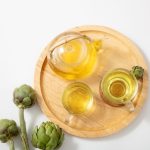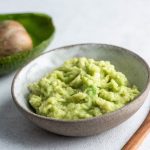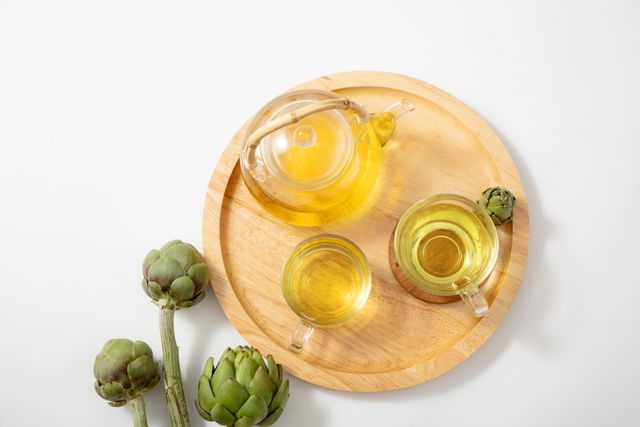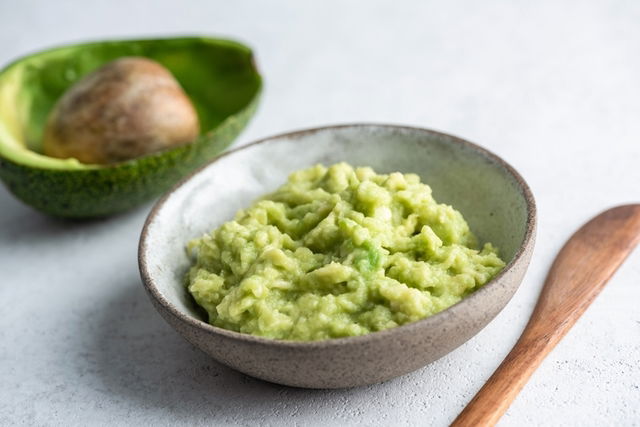

Home remedies to lower cholesterol, such as artichoke, flax seeds or garlic water, contain fiber, omega-3 and antioxidants that help reduce the absorption of fat, increasing its excretion in the feces or preventing its oxidation. thus regulating cholesterol levels in the blood.
Although they are indicated to control cholesterol, these home remedies do not replace the treatment indicated by the cardiologist, and they should be part of a healthy and balanced diet. See what the diet should be like to lower cholesterol.
Cholesterol is a greasy, whitish, odorless substance that cannot be seen with the naked eye and cannot be tasted when eating food. The main types of cholesterol are HDL (good) cholesterol, which should be above 60 mg/dl, LDL (bad) cholesterol, which should be below 130 mg/dl, and VLDL, which should be below 30 mg/dl. dl.

artichoke tea
Main home remedies
Some home remedies to help lower cholesterol are:
1. Artichoke
The artichoke is rich in antioxidants, mainly luteolin, which helps prevent the formation of cholesterol and increases the excretion of bile, facilitating the excretion of cholesterol.
In addition to that, artichoke leaf extract is also a liver protector, due to the action of capturing free radicals that produce cellular oxidation.
How to use: The artichoke can be consumed boiled in the form of tea or supplement. To cook it, bring the water to a boil, once it reaches the boiling point, reduce the heat to low and add the artichoke for 30 minutes until it is soft. See how to prepare the tea and consume the artichoke supplement.
In the case of artichoke tea, simply add 1 to 2 grams of artichoke leaves to a cup of boiling water for about 10 minutes. Then strain, let cool a little and drink.
2. Flaxseed or flax seeds
Because they are rich in fiber and omega-3, flax seeds also help reduce cholesterol, as they prevent the oxidation of fat cells and help accelerate intestinal transit.
How to use: Add 1 tablespoon (10g) of flax seeds to soups, salads, yogurts, juices, milk, pancakes or smoothies. These should be consumed crushed in a blender or purchased in the form of flour, since the intestine cannot digest the whole grain of flaxseed.
3. Fenugreek
Being rich in fiber, fenugreek seeds help reduce the absorption of fats from food, which makes the plant capable of regulating “bad” cholesterol levels.
How to use: Fenugreek can be consumed in tea or supplement form. To prepare the tea, add 2 teaspoons of fenugreek seeds to 1 cup of cold water and let it steep for about 3 hours. Next, boil the ingredients, strain and consume while warm. Drink up to 3 times a day. See how to consume fenugreek supplement.
4. Garlic water
Garlic helps reduce levels of “bad” LDL cholesterol and triglycerides in the blood because they inhibit their oxidation, thus reducing the risk of heart disease. In addition, it also has other properties, since garlic is also anti-inflammatory, antimicrobial and anti-cancer.
How to use: To prepare the garlic water, place 1 clove of crushed garlic in 100 ml of water, and let the mixture rest overnight. The next day, on an empty stomach, you should remove the garlic and consume the water. See how to consume garlic capsules.
5. Oats
Oats are rich in a specific type of fiber, known as beta-glucan, which lowers blood cholesterol levels and also reduces the risk of serious cardiovascular diseases, such as heart attack or stroke.
How to use: To obtain this benefit, it is recommended to eat at least 3 tablespoons of flaked oats a day, which can be added to yogurts, cereals, smoothies, juices or can simply be consumed as oatmeal porridge.
6. Brewer’s yeast
The beta-glucans present in brewer’s yeast help reduce cholesterol absorption at the intestinal level, regulating the levels of “bad” LDL cholesterol in the blood. Likewise, its chromium content helps increase levels of good HDL cholesterol in the blood. See other benefits of brewer’s yeast.
How to use: To obtain all the benefits of brewer’s yeast powder, just consume 1 to 2 tablespoons raw per day, and it can be added to juices, smoothies, soup, yogurts, milks and even a glass of water.
7. Turmeric
Turmeric is a spice rich in antioxidants, mainly curcumin, which helps reduce “bad” LDL cholesterol, thus preventing the emergence of cardiovascular diseases. Learn what turmeric is for.
How to use: In addition to seasoning food, you can also prepare a tea with turmeric or consume it in capsules. To prepare turmeric tea, it is necessary to place 1 teaspoon of powder in 150 ml of boiling water, letting the infusion rest for about 10 to 15 minutes. Once warm, you should drink up to 3 cups a day between meals.
8. Dandelion
Dandelion leaves have antioxidant properties that prevent the damage caused by oxidative stress to cells and reduce levels of triglycerides and “bad” LDL cholesterol in the blood.
In this way, this medicinal plant helps prevent the development of cardiovascular diseases, such as atherosclerosis, myocardial infarction or stroke, for example. See other benefits of dandelion.
How to use: Dandelion can be used to prepare tea or naturally for cooking, in salads or juices, for example. To prepare the tea, you can add 1 or 2 teaspoons of dandelion root to 200 mL of boiling water, letting it steep for 10 minutes. Strain and drink warm up to 3 times a day.
9. Malojillo
Malojillo has bioactive compounds such as limonene and geraniol, which have antioxidant properties, helping to neutralize free radicals and prevent the oxidation of fat cells, helping to reduce the levels of “bad” LDL cholesterol and triglycerides, preventing diseases. cardiac. See all the benefits of malojillo.
How to use: malojillo can be used to prepare tea, simply add 1 teaspoon of chopped malojillo leaves to 1 cup of boiling water. Cover, let sit for 10 minutes, strain and drink warm 3 to 4 cups a day.
Recipes to lower cholesterol

Avocado cream
These recipes are excellent strategies to lower cholesterol, being excellent options as healthy and balanced meals, see how to prepare them below:
1. Avocado cream
Avocado cream is rich in healthy fats and antioxidants that help reduce bad cholesterol. To prepare this cream you must blend 1 ripe avocado with 100 ml of skim milk and sweeten to taste. Learn about other benefits of avocado.
2. Eggplant pancakes with flaxseed
Eggplant has functional properties that help balance cholesterol and triglycerides; In the case of flax seed, it is rich in omega 3 and 6, creating a rubber in the stomach that prolongs the feeling of satiety from food, helping in the weight loss process.
Ingredients
- 1 cup whole wheat flour;
- 1 cup skim milk;
- 1 egg;
- 1/4 olive oil;
- Salt and oregano to taste;
- 1 eggplant;
- 1 shredded chicken breast.
Preparation mode
To prepare the dough, blend the milk, flour, egg and add the olive oil, salt and oregano. For the filling, sauté the eggplant with the shredded chicken breast and season to taste.
Another option is to slice the eggplant and bake with seasonings such as fresh garlic, salt, onion, lemon and curry. Learn how to consume eggplant.
3. Lettuce salad with carrot and lemon
Lettuce salad with carrot and lemon contributes to cholesterol reduction because it has a low fat content.
To prepare it, place the chopped lettuce, grated raw carrot, and sliced onion in a container and season with 1 squeezed lemon and a few fresh cloves of garlic.
4. Stir-fried green soybeans
Green soybeans, also called mung beans, Chinese beans or mung beans, contain isoflavones that help reduce cholesterol. They are low in fat and the quality of soy protein is very similar to that of meat, with the advantage that it does not contain cholesterol, surpassing in quality all other vegetable proteins.
To prepare it, you must cook the green soybeans in water and when it is soft, season with soy sauce, vinegar and ginger powder.
5. Brown rice with carrot
Brown rice with carrot is rich in fiber that promotes the elimination of fat molecules through the feces, as well as B complex vitamins, minerals such as zinc, selenium, copper and manganese, as well as phytochemicals with antioxidant action. The outer layer of brown rice contains oryzanol, a substance known to prevent and control cardiovascular diseases.
To prepare it, sauté brown rice with garlic, onion and salt and then add water and grated carrot.
What should the diet be like?
To lower “bad” LDL cholesterol, it is recommended to follow a healthy and balanced diet, which should include sources of good fats such as olive oil, salmon, tuna, olives, avocados and nuts, such as walnuts or almonds, because they are foods rich in omega 3. In addition, the consumption of fiber from fruits, vegetables and whole grains is of utmost importance, since fiber promotes the excretion of cholesterol through feces.
Learn in more detail what the diet to lower cholesterol should be like and watch the video below: